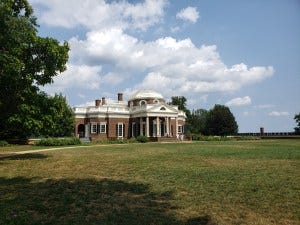Historical Presentation, Two Ways
If you have the chance to travel to Charlottesville, Virginia and are interested in history, the area is fantastic for exploring the landscapes of the early American republic. Two estates of former Presidents – and good friends – are within only a few minutes’ drive of one another: James Monroe’s Highland and Thomas Jefferson’s Monticello. The differences in how each estate is presented to visitors are a microcosm of contemporary society and tell us quite a bit about where things may be going culturally.
To start, I’d absolutely recommend visiting both Highland and Monticello if you’re at all a fan of history or early Americana; both are fascinating places that – especially on a beautiful day like we had – are wonderful to walk around and explore. (As a sidebar, you absolutely must have lunch at Michie Tavern, a classic Southern buffet that has been a working tavern on and off since 1784. The food is great and the period-accurate atmosphere is unparalleled.) Still, I must say that I found Highland to be far more informative, interesting, and nuanced.
Thomas Jefferson’s Monticello (seen directly above) is a UNESCO World Heritage Site, can be seen on the back of the Nickel, and is quite possibly the most famous estate in the United States. Jefferson himself designed it and it served as his home in retirement, as well as being a large-scale working plantation – with all the associated outbuildings, gardens, and, infamously, slaves. It is a truly massive property that clearly is well-financed, expensively curated, and heavily-visited and staffed. Despite all of those seeming advantages, Monticello was an underwhelming experience that myopically focused on slavery to the detriment of the visitor’s historical understanding. Yes, Jefferson owned hundreds of slaves during his life, many of whom lived at Monticello; he also had a sexual relationship with at least one slave, Sally Hemings, that produced several offspring. All of this is both useful information and necessary context to Jefferson’s life and the importance of his estate. But if you came into your visit with no knowledge of Jefferson besides the fact that he was an American President, you’d leave with very little new information that didn’t wholly revolve around slavery. This is a dereliction of duty and seems to be influenced by modern cultural politics more than anything else. Slavery was a (terrible) fact of life in the Virginia of Jefferson and Monroe; Jefferson himself had a deeper relationship with the “peculiar institution” than did many of his contemporaries. The fact of enslavement of black persons is a key part of the tale of Monticello and of Jefferson, but it is not the only part. The curation at Monticello flattens Jefferson into a typical Southern slaveholder, with all the baggage that carries; this does a disservice to the complexity of his life and legacy. I’m personally not the biggest Jefferson fan, but I was sorely disappointed that the estate to which he dedicated so much of his time seemed to ignore his achievements entirely in favor of a simplified narrative wholly focused on his ownership of slaves.
James Monroe’s Highland (seen at top of post), on the other hand, was far smaller, quainter, and less well-resourced in terms of funding. Even with those relative disadvantages, Highland was a fabulous historical experience which more fully fleshed out the importance of Monroe as a statesman and explored the truly intriguing history of the estate itself. The tour was informative, detailed, and delved into Monroe’s life story, his turbulent history with the estate, and the archaeological study of the premises which has revealed new information previously unknown until the past few years. The exhibits and guides discussed Monroe’s ownership of slaves and their role on the property, but presented it in a more nuanced manner; for instance, the main guest house, which is still standing, was built and designed by two enslaved men whose story was discussed in a manner that respected their craft but that did not whitewash the fact of their condition. Besides the guided tour of the main area of Highland – Monticello only offered an extremely sub-par audio guide of the house, but had long slavery-focused guided tours available – there was also an exhibit on Monroe’s foreign policy statesmanship that was full of unique items and factual displays that explained the significance of Monroe’s career in this crucial area of policy. Even as an admirer of Monroe and a huge foreign policy nerd, this exhibit presented me with new insights and knowledge. In a way, Highland felt like a throwback to a different era of historical presentation, where curators and guides explained in detail, focused on historical perspective, and worked with a great deal of nuance. Compared to the presentation of Monticello, this was a breath of fresh air.
Not only was Highland a great deal more engaging than was Monticello, it was also quite a good bit cheaper to visit. It was less influenced by present-day political and cultural concerns, but still dealt with the historical reality of slavery in a respectful and appropriate manner. It is a shame that Monticello is endowed with such a greater amount of financial heft than is Highland, but this is a sign of the times; those who donate to and sustain these institutions are interested as much in today’s cultural politics as they are in history. Based on these visits, I fervently hope this shifts over time, both in terms of historical presentation and broader cultural politics. The legacies of these incredible Americans deserve nothing less.





